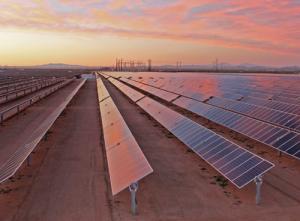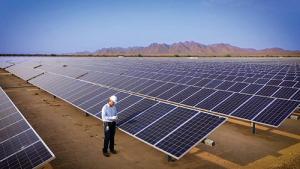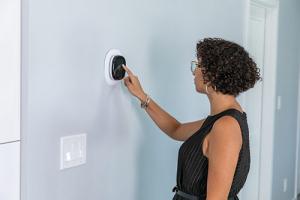Arizona Public Service
Daniel Haughton is Director of our Customer to Grid Solutions team at Arizona Public Service. Kerri Carnes is Manager of Product Development and Strategies at Arizona Public Service. Eric Massey is the Director of Arizona Public Service's Sustainability Program.
I'm pretty sure it's no secret that Arizona is a hot place to be. But I was shocked to learn that parts of Arizona Public Service's service territory can reach temperatures below freezing. It's a testament to the variety of challenges utilities face when they're working to keep the lights on. PUF recently caught up with APS to learn about some of the projects it has underway to support utility customers in the Grand Canyon state. We sat down with Daniel Haughton, Kerri Carnes, and Eric Massey to take a deep dive into these projects that are particularly serving the public interest.

The projects discussed herein aren't intended to be just good service, but equitable service — another important focus for our industry. We discussed sustainability practices that keep in mind the communities most impacted by changes in technology and infrastructure. The conversation reminds me that serving the public interest is it's not as simple as two sides of a coin, but maybe more like a multi-sided die we're all miraculously keeping balanced on one vertex.
— PUF's Rachel Moore
PUF: Daniel, talk about your job at Arizona Public Service and describe a typical day.
Daniel Haughton: I'm Director of our Customer to Grid Solutions team. That team focuses on creating solutions that involve customers and provide grid benefits.
 APS employee at the Desert Star Solar Plant.
APS employee at the Desert Star Solar Plant.
We describe ourselves as the bridge between what our customers want and the technologies they're adopting and what the grid needs. That includes our innovative projects, the APS Cool Rewards program, the thermostat aggregations.
We have electric vehicles and electrification in the strategy to help facilitate the burgeoning growth of electric vehicles. We have other programs that focus on demand-side management and energy efficiency.
My teams also work with the integration of renewable resources like all the rooftop solar systems in our service territory. About one in ten of our customers have rooftop solar; that's about one hundred and thirty thousand customers out of a population of about 1.3 million customers.
PUF: Kerri, what's your job and what do you do on a typical day?
 APS employee with an ecobee3 lite smart thermostat.
APS employee with an ecobee3 lite smart thermostat.
Kerri Carnes: I work as the Manager of Product Development and Strategies. My team is responsible for many programs that Daniel mentioned. We work directly with our customers to understand what their challenges are and what the opportunities are, so we can design beneficial solutions, programs, or services to meet those needs.
PUF: Daniel, how do you decide which initiatives you're going to focus on?
Daniel Haughton: The answer comes down to alignment with our goals and objectives — driven by needs of our stakeholders, regulators, customers — and the commitments we make to the future and prosperity of our state.
At APS, we have our Clean Energy Commitment and the APS Promise. Those two are the ultimate anchor for helping us filter decisions by asking ourselves, "Does this help us achieve our long-term goals and objectives of creating cleaner, more environmentally-friendly solutions and doing what's right for the customer?"
Our Clean Energy Commitment is a bold goal we set to serve customers with one hundred percent clean, carbon-free energy by 2050. It's a long-term commitment, but some of the nearer-term interim targets that help us prioritize projects, ideas, and decisions, include the 2030 interim timeline to achieve a sixty-five percent clean energy mix.
Of that sixty-five percent, forty-five percent of the total portfolio will come from renewables. Today, we're at fifty percent clean with existing nuclear in our portfolio, and what makes up the rest of that clean number are some of the programs this team runs, which are demand-side management and energy efficiency.
Those solution help us meet the energy needs of our customers on an annual basis today. For example, a significant percent comes from demand-side management and energy efficiency initiatives, and another significant percent comes from renewables. When you think forward about 2035, the plans would see us achieve about eighty percent clean.
PUF: Eric, what is your job, and what is your typical day like?
Eric Massey: I'm the Director of our Sustainability Program. We were developed in the last two years as a stand-alone business unit to support and continue championing our Clean Energy Commitment, while looking at the environmental, social, and governance policy.
So, we think about environmental stewardship. This is about combining that with looking toward the future, so we have a full, complete circle of work. We're intentionally driving the work we want to do as a company, not just telling the story.
What you've seen us do this last year is make sure we're preparing the company for potential federal legislation. We were tracking the developments in the Build Back Better program.
Another place where we spend a lot of time is the social responsibility of our decisions. We're going to go through a significant transition for our Clean Energy Commitment. There are societal impacts that manifest in the context of communities that will no longer be as supported by APS as once they were, like our rural communities where we have coal-fired power plants.
As we look to transition away from those plants, those communities remain. APS looks at them and says, we have family, friends, and employees in those communities.
The next step of looking at the environmental benefits is understanding how we balance some of the social impacts that go along with those decisions. In our most recent rate case, what you saw was a focus on developing what we call our Coal Communities Transition package.
That was a proposal we made to the Arizona Corporation Commission to support communities, specifically for the Navajo Nation, the Hopi tribe, and communities in Navajo County that surround our power plant, with monetary and in-kind services. Not all of it was approved as part of our recent rate case, but some elements were, and we're getting started on those approaches.
PUF: How do you know something's going to resonate with customers?
Kerri Carnes: It's an important part of the product development process, incorporating the voice of the customer into our design process. We've renewed our focus to ensure we're incorporating the voice of the customer into our design, because we don't want to simply make a product or a program available and then just leave it and not check back in.
We want to keep taking the pulse and understanding if our programs are working for our customers. Do they like them? Are they engaging with them? Last summer, before we launched the APS Marketplace, we leveraged APS's Customer Advisory Board and did some secret shopper campaigns. We did a couple of different testing points to gather actionable feedback and make improvements.
We've seen tremendous success with that platform in the first year that it's been available to our customers. That is a perfect example of a time when we didn't just make a tool available. We took it to a lot of different groups.
PUF: You've got a number of programs to help customers, what are the most important programs you are doing?
Daniel Haughton: Some of the internal groups we work with include teams that are looking at what our generation resource mix will look like five, ten, twenty, or thirty years from now. We're working with the customer experience team making sure we've got the right messages, that customers have the right experiences, and we're measuring our performance objectively, benchmarking across the industry.
The teams that are going out into the field day to day restoring power when there's an outage, or connecting your service if you're a new customer, we call them our Transmission and Distribution organization. We work closely with those teams to help identify needs, get objective feedback, and learn what customers are saying about their experiences.
Then we work closely with state regulatory organizations to serve customers across the spectrum, which includes limited-income and diverse communities, and you've got regional considerations or concerns.
Folks think of Arizona as being a hot, dry climate. APS serves Flagstaff and Sedona and folks up on the Mogollon Rim. Temperatures in Flagstaff can be freezing or below freezing. There's a variety of unique customer challenges and resource needs across our service territory.
The solutions we develop have to be tailored to the needs of those specific customers where they are. To pull it back to the APS Promise, it's doing what's right for each of those communities, and we think very long-term. How can we build sustainable solutions in each of those spaces?
PUF: What are the most impactful programs you've got going?
Kerri Carnes: The one I want to dive in on is the APS Cool Rewards Program. That's our residential demand-response program. It brings energy-savings benefits to our customer and helps advance a cleaner and more reliable electric system. We were seeing success with that program, and at the end of summer 2020, we entered into a partnership with Google to make up to one hundred thousand thermostats available to our customers at no cost to them.
Since the end of the summer season in 2020 to the end of this summer season, we doubled the size of the program. Google came to the table to help us do that. We currently have more than fifty-two thousand enrolled residential thermostats in the program and this past summer APS Cool Rewards helped shed nearly eighty megawatts of electricity from our smart grid.
The main driver was our marketplace provider, a company called Enervee. We instituted demand-response pre-enrollment so customers could have a more seamless experience when they visited the APS Marketplace online; they could automatically enroll at the point of purchase.
All the rebates and incentives would come off the top, making those thermostats more accessible. As a result, we saw tremendous uptake. In the first year, we sold about forty thousand thermostats through the marketplace at a rate of ninety-seven percent pre-enrollment, so that's tremendously successful.
One of our partners said we had one of the best performing marketplaces across the country, but most especially in a utility that is only serving in one state. We're proud of that.
We leverage those connected devices during the summer when we need capacity the most and we'll shift some energy usage into the middle of the day when we have an abundance of clean resources on the system to pre-cool our customers' homes, so when we enter into the demand-response event during the on-peak period, we're protecting the comfort of our customers.
Customer convenience, control, and comfort are the cornerstones of that program. We also make sure we continue engaging the voice of the customer and understanding their experience.
After an event, we'll do a post-event survey to ask about their experience, comfort, and if they intend to continue to participate. We can take that feedback and make actionable improvements to the program. One of those bits of feedback from this summer season was customers wanted more of an annual award for participating.
There was a feeling that for their participation, they should be compensated more. We took that seriously. We checked it against best practices across the industry.
Now we're excited to share that because of that customer feedback, we're going to be increasing the annual participation award in 2022. The Cool Rewards Program is the bright shining light.
PUF: Eric, why are these programs important?
Eric Massey: When you look at the community aspects, there's a benefit for the customer in reduced costs. There's a benefit in having additional reliability through our times of peak usage. But, from a sustainability perspective, there's an environmental benefit.
This kind of a demand-side response where customers reduce their usage helps us plan our resources as we work towards 2050. The other side of that coin is you're reducing your usage when carbon emissions are the highest. During peak periods, like the summer season, there may be times where we may have to rely on all of our resources to meet the demands, including our fossil generation and coal plants.
We need that to provide reliable electric service to customers. But, when customers can say we're going to avoid using almost eighty megawatts of energy, that reduces carbon emissions during those time periods of peak demand.
These types of innovative programs also help us bring affordable service to customers. When we talk about how we plan our system, our three big metrics are affordability, reliability, and clean.
PUF: You have regulatory, state government, the consumer, different departments in the company. How do you build consensus?
Daniel Haughton: Where APS works to build consensus and create sustainable solutions is through alignment: what can we align on, move forward, and how can we make progress? We look for opportunities to have dialogue and find places where we can drive consensus and agreement.
We have different groups called collaboratives, one of them being the demand-side management or DSM collaborative, where, in the past, stakeholders may not have felt as engaged or had as loud a voice. That's why we now meet a couple of times a year with our stakeholder groups to discuss plans and proposed solutions.
Everyone gets a chance to weigh in and collaborate. It's important for state regulators to see programs like DSM, how broadly supported they are by the stakeholder community, and to see that they have had an opportunity to participate in dialogue about the programs.
PUF: What's coming in the next two, three, four, five years that's going to be exciting and impactful?
Kerri Carnes: EVs, transportation and electrification are the next big thing for us, making sure we have our system prepared to serve our customers who are adopting electric cars sooner than later. Making sure we're designing programs for customers to be able to participate in for those early adopters, but also thinking longer term and how we ensure equity in all the programs that we're thinking about.
We recently kicked off a transportation electrification collaborative so we can have these conversations with stakeholders, consumer advocates, and be thinking about what we need to do to make sure we're prepared for the future, like designing rates to encourage customers to charge at the right times of the day.
Eric Massey: In terms of equity, we're thinking long term about our customers with limited income and how we can help them afford some of the transition. With electric vehicles, part of the issues are the price points and those are policy pieces we've got to continue working on.
We want to meet communities where their needs are, but just throwing a bunch of EV chargers in communities that don't have electric vehicles isn't an equitable solution. It's not going to be the thing that encourages people to adopt that. How do we partner with Daniel and his team to smartly roll those out and make sure there's equitable benefit to customers from those programs?
We have our eyes on things like hydrogen development, utilizing existing infrastructure, making significant changes to our existing fleet of gas-fired units, and then going forward without emitting carbon again. It's science based, but it also has significant challenges.
Daniel Haughton: Even if APS gets to one hundred percent decarbonization by 2050, if nothing changes on the customer's end, and if the end uses of energy and end products are still reliant on carbon-based fuel sources, then we haven't advanced society as much as we need to.
It's about decarbonization, expanding beyond the electric utility sector, into transportation, into buildings and industries, and agriculture and other sectors of the economy. Nationally, transportation accounts for a larger percent of total emissions than utilities. There's your opportunity to help drive decarbonization with transportation electrification.
Lead image: The APS Red Rock Solar Plant.



